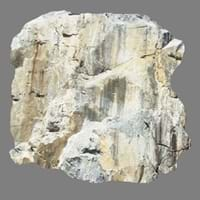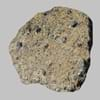Definition
Trondhjemite is a leucocratic (light-colored) intrusive igneous rock. It is a variety of tonalite in which the plagioclase is mostly in the form of oligoclase. Trondhjemites are sometimes known as plagiogranites.
A hydration and metamorphic transformation of ultramafic rock from the Earth's mantle is called as serpentinization, a group of minerals is formed by serpentinization compose rock 'serpentinite'.
Discoverer
Unknown
Unknown
Etymology
Not Available
From English word serpentinization.
Class
Igneous Rocks
Metamorphic Rocks
Sub-Class
Durable Rock, Hard Rock
Durable Rock, Medium Hardness Rock
Group
Plutonic
Not Applicable
Other Categories
Coarse Grained Rock, Fine Grained Rock, Medium Grained Rock, Opaque Rock
Fine Grained Rock, Opaque Rock
Texture
Phaneritic
Earthy
Color
Black, Brown, Light to Dark Grey, White
Black, Brown, Colourless, Green, Grey, White
Durability
Durable
Durable
Appearance
Banded and Foilated
Rough and Dull
Interior Uses
Decorative Aggregates, Entryways, Flooring, Homes, Interior Decoration
Decorative Aggregates, Interior Decoration
Exterior Uses
As Building Stone, As Facing Stone, Paving Stone, Garden Decoration, Office Buildings
As Building Stone, Paving Stone, Garden Decoration, Office Buildings
Other Architectural Uses
Curbing
Curbing
Construction Industry
As Dimension Stone, Cement Manufacture, Cobblestones, Construction Aggregate, for Road Aggregate
As Dimension Stone, Cement Manufacture, for Road Aggregate, Making natural cement
Medical Industry
Not Yet Used
Not Yet Used
Antiquity Uses
Artifacts, Monuments, Sculpture, Small Figurines
Artifacts, Jewellery, Monuments, Sculpture
Commercial Uses
Cemetery Markers, Creating Artwork
Commemorative Tablets, Creating Artwork
Types
Not Available
Jadeitite
Features
Is one of the oldest rock, Typically speckled black and white.
Host Rock for Lead
Archaeological Significance
Monuments
Not Yet Used
Used
Famous Monuments
Not Applicable
Data Not Available
Famous Sculptures
Data Not Available
Data Not Available
Pictographs
Not Used
Used
Petroglyphs
Not Used
Used
Formation
When alkali feldspar is extracted from granite, it changes to granitoid and later, it becomes trondhjemite with quartz as major mineral.
Due to change in environmental conditions, rocks are heated and pressurized deep inside the Earth's surface. Serpentinite is formed from the extreme heat caused by magma or by the intense collisions and friction of tectonic plates.
Mineral Content
Albite, Amphibole, Apatite, Biotite, Feldspar, Hornblade, Ilmenite, Magnetite, Manganese Oxides, Olivine, Plagioclase, Pyroxene, Quartz, Sulfides, Titanite, Zircon
Carbonate, Magnetite, Pyrrhotite, Serpentine, Sulfides
Compound Content
NaCl, CaO, MgO, Silicon Dioxide
Ca, CaO, Carbon Dioxide, KCl, MgO, Sulfur Dioxide, Sulphur
Types of Metamorphism
Burial Metamorphism, Cataclastic Metamorphism, Contact Metamorphism, Impact Metamorphism, Regional Metamorphism
Burial Metamorphism, Cataclastic Metamorphism, Contact Metamorphism, Hydrothermal Metamorphism, Impact Metamorphism
Types of Weathering
Biological Weathering, Chemical Weathering, Mechanical Weathering
Not Applicable
Types of Erosion
Chemical Erosion, Coastal Erosion, Glacier Erosion, Sea Erosion, Water Erosion, Wind Erosion
Chemical Erosion, Coastal Erosion, Glacier Erosion, Sea Erosion, Wind Erosion
Grain Size
Medium to Fine Coarse Grained
Very fine-grained
Fracture
Conchoidal
Uneven
Streak
Bluish Black
White, Greenish White or Grey
Porosity
Very Less Porous
Less Porous
Luster
Subvitreous to Dull
Waxy and Dull
Compressive Strength
Not Available
Cleavage
Not Available
Irregular
Specific Gravity
2.86-3
2.79-3
Transparency
Opaque
Opaque
Density
2.73 g/cm3
2.5-3 g/cm3
Resistance
Heat Resistant, Pressure Resistant, Wear Resistant
Heat Resistant
Deposits in Eastern Continents
Asia
Not Yet Found
India, Saudi Arabia, Singapore, South Korea
Africa
Egypt
Ethiopia, Western Africa
Europe
Finland, Germany, Italy, Romania, Sweden, Turkey
England, Georgia, Switzerland, United Kingdom
Others
Not Yet Found
Not Yet Found
Deposits in Western Continents
South America
Argentina, Bolivia, Chile, Colombia, Ecuador, Peru
Colombia
Deposits in Oceania Continent
Australia
New Zealand, South Australia, Western Australia
Central Australia, New South Wales, New Zealand, Western Australia










